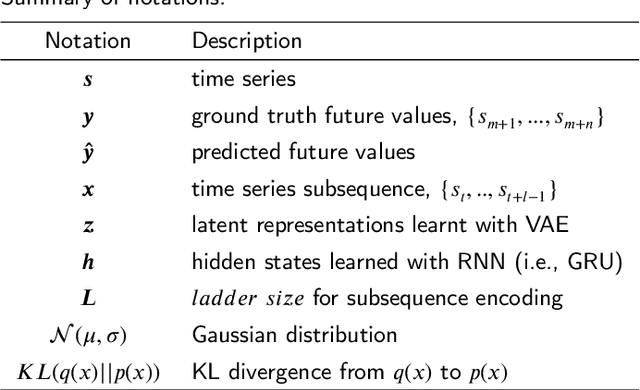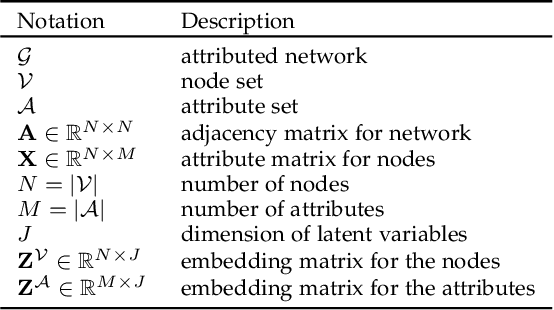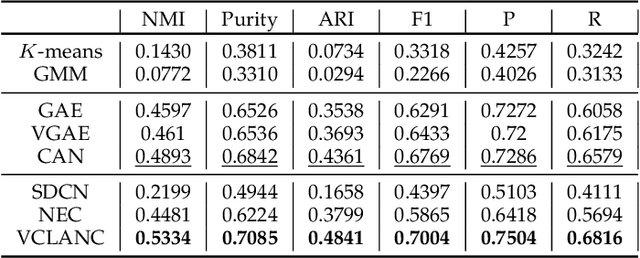Borui Cai
SS-shapelets: Semi-supervised Clustering of Time Series Using Representative Shapelets
Apr 06, 2023Abstract:Shapelets that discriminate time series using local features (subsequences) are promising for time series clustering. Existing time series clustering methods may fail to capture representative shapelets because they discover shapelets from a large pool of uninformative subsequences, and thus result in low clustering accuracy. This paper proposes a Semi-supervised Clustering of Time Series Using Representative Shapelets (SS-Shapelets) method, which utilizes a small number of labeled and propagated pseudo-labeled time series to help discover representative shapelets, thereby improving the clustering accuracy. In SS-Shapelets, we propose two techniques to discover representative shapelets for the effective clustering of time series. 1) A \textit{salient subsequence chain} ($SSC$) that can extract salient subsequences (as candidate shapelets) of a labeled/pseudo-labeled time series, which helps remove massive uninformative subsequences from the pool. 2) A \textit{linear discriminant selection} ($LDS$) algorithm to identify shapelets that can capture representative local features of time series in different classes, for convenient clustering. Experiments on UCR time series datasets demonstrate that SS-shapelets discovers representative shapelets and achieves higher clustering accuracy than counterpart semi-supervised time series clustering methods.
From Wide to Deep: Dimension Lifting Network for Parameter-efficient Knowledge Graph Embedding
Mar 22, 2023



Abstract:Knowledge graph embedding (KGE) that maps entities and relations into vector representations is essential for downstream tasks. Conventional KGE methods require relatively high-dimensional entity representations to preserve the structural information of knowledge graph, but lead to oversized model parameters. Recent methods reduce model parameters by adopting low-dimensional entity representations, while developing techniques (e.g., knowledge distillation) to compensate for the reduced dimension. However, such operations produce degraded model accuracy and limited reduction of model parameters. Specifically, we view the concatenation of all entity representations as an embedding layer, and then conventional KGE methods that adopt high-dimensional entity representations equal to enlarging the width of the embedding layer to gain expressiveness. To achieve parameter efficiency without sacrificing accuracy, we instead increase the depth and propose a deeper embedding network for entity representations, i.e., a narrow embedding layer and a multi-layer dimension lifting network (LiftNet). Experiments on three public datasets show that the proposed method (implemented based on TransE and DistMult) with 4-dimensional entity representations achieves more accurate link prediction results than counterpart parameter-efficient KGE methods and strong KGE baselines, including TransE and DistMult with 512-dimensional entity representations.
Hybrid Variational Autoencoder for Time Series Forecasting
Mar 13, 2023



Abstract:Variational autoencoders (VAE) are powerful generative models that learn the latent representations of input data as random variables. Recent studies show that VAE can flexibly learn the complex temporal dynamics of time series and achieve more promising forecasting results than deterministic models. However, a major limitation of existing works is that they fail to jointly learn the local patterns (e.g., seasonality and trend) and temporal dynamics of time series for forecasting. Accordingly, we propose a novel hybrid variational autoencoder (HyVAE) to integrate the learning of local patterns and temporal dynamics by variational inference for time series forecasting. Experimental results on four real-world datasets show that the proposed HyVAE achieves better forecasting results than various counterpart methods, as well as two HyVAE variants that only learn the local patterns or temporal dynamics of time series, respectively.
Temporal Knowledge Graph Completion: A Survey
Jan 16, 2022
Abstract:Knowledge graph completion (KGC) can predict missing links and is crucial for real-world knowledge graphs, which widely suffer from incompleteness. KGC methods assume a knowledge graph is static, but that may lead to inaccurate prediction results because many facts in the knowledge graphs change over time. Recently, emerging methods have shown improved predictive results by further incorporating the timestamps of facts; namely, temporal knowledge graph completion (TKGC). With this temporal information, TKGC methods can learn the dynamic evolution of the knowledge graph that KGC methods fail to capture. In this paper, for the first time, we summarize the recent advances in TKGC research. First, we detail the background of TKGC, including the problem definition, benchmark datasets, and evaluation metrics. Then, we summarize existing TKGC methods based on how timestamps of facts are used to capture the temporal dynamics. Finally, we conclude the paper and present future research directions of TKGC.
Variational Co-embedding Learning for Attributed Network Clustering
Apr 15, 2021



Abstract:Recent works for attributed network clustering utilize graph convolution to obtain node embeddings and simultaneously perform clustering assignments on the embedding space. It is effective since graph convolution combines the structural and attributive information for node embedding learning. However, a major limitation of such works is that the graph convolution only incorporates the attribute information from the local neighborhood of nodes but fails to exploit the mutual affinities between nodes and attributes. In this regard, we propose a variational co-embedding learning model for attributed network clustering (VCLANC). VCLANC is composed of dual variational auto-encoders to simultaneously embed nodes and attributes. Relying on this, the mutual affinity information between nodes and attributes could be reconstructed from the embedding space and served as extra self-supervised knowledge for representation learning. At the same time, trainable Gaussian mixture model is used as priors to infer the node clustering assignments. To strengthen the performance of the inferred clusters, we use a mutual distance loss on the centers of the Gaussian priors and a clustering assignment hardening loss on the node embeddings. Experimental results on four real-world attributed network datasets demonstrate the effectiveness of the proposed VCLANC for attributed network clustering.
 Add to Chrome
Add to Chrome Add to Firefox
Add to Firefox Add to Edge
Add to Edge